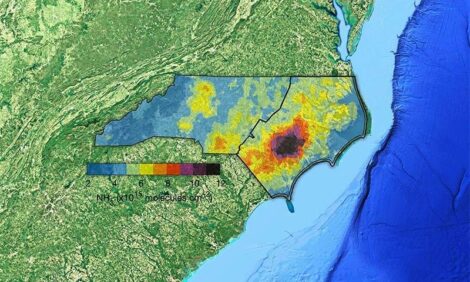



Pork Outlook Report - August 2003
By U.S.D.A., Economic Research Service - This article is an extract from the August 2003: Livestock, Dairy and Poultry Outlook Report, highlighting Global Pork Industry data. The report indicates that pork production in 2003 is expected to be about even with last year.| Overview |

Small increases in slaughter continue to push 2003 U.S. pork production closer to last
year’s production mark.
Hog producers are expected to receive 14 percent higher prices
for their hogs this year, while retail pork price forecasts are 1 percent lower, so
packer/processors, wholesalers, and retailers are likely to divide smaller returns this year.
U.S. pork exports are expected to increase despite Japan’s Safeguard imposition on
August 1. The United States is expected to import 6.1 million hogs from Canada, with a
somewhat larger proportion expected to be slaughter animals this year, than in 2002.
| Expected Pork Production in 2003 About Even With Last Year |
|
Retail Pork Price
Percent change from previous month 
|
The U.S. pork industry finished the second quarter with a hog slaughter of 23.9 million head, slightly ahead of earlier expectations. Higher slaughter occurred in June, with producers likely marketing hogs aggressively to take advantage of seasonally high hog prices. Larger imports of Canadian slaughter hogs in June are also another likely factor contributing to larger than expected slaughter numbers. The same dynamic larger-than-expected slaughter spilled over into July, causing thirdquarter slaughter expectations to increase to 24.5
million head. If expectations are realized, about 1 percent fewer animals will be slaughtered this year, but about the same quantity of pork as last year will be produced - 19.6 billion pounds - due to dressed weights of slightly more than 1 pound greater than last year.
Wholesale pork prices, as measured by the Composite Cutout, declined seasonally in July and
into August, effectively limiting what processors can bid for hogs. After trading at levels 26 percent above year-earlier levels in June, the July cutout averaged just 10 percent over July 2002, and continued to decline into August. Of the primal cuts that comprise the cutout- loins, butts, picnics, ribs, hams, and bellies, only picnics, hams, and bellies continue to trade at or above year-earlier levels. Loins showed particular weakness moving into the third quarter, as expectations for greater demand due to BSE related factors were not realized, together with the Japanese Safeguard, imposed August 1, likely limited expected nearterm
export demand for higher valued cuts.
|
Weekly Hog Slaughter
Percent change from last year 
|
Third-quarter hog prices — National Base Cost, 51-52 percent lean, live equivalent — are expected to range between $41 and $43 per cwt, in the third quarter, for an annual average of $39-$40, almost 14 percent above last year’s average. In the first three quarters of 2003, retail pork prices will likely average in the low $2.60s per pound, or, almost 2 percent less than in the same period last year. Consumers are thus paying less, for a slightly smaller supply of pork, while producers are receiving about 14 percent more for a slightly smaller supply of hogs. Packers/processors, wholesalers, and retailers are thus sharing smaller
spread, so far this year.
| U.S. Exports Expected to Exceed 2002 Levels, Despite 25 Percent Increase in Japanese Gate Price |
Through the first 6 months of 2003, U.S. pork exports continue to run ahead of the same period last year. The United States exported 851 million pounds through June, more than 5 percent greater than a year ago. On a cumulative basis for the first 6 months of 2003, percent changes in the same period year-over-year exports for Japan, Mexico, and Canada were +9 percent, -9 percent, and -17 percent.
Together, these three countries accounted for 79 percent of U.S. pork exports, down from 83 percent for the same period in 2002. Smaller Asian markets, the European Union, and the “Other” category of countries importing U.S. pork, together helped to push U.S. exports beyond year-earlier levels. Total U.S. exports for 2003 are expected to be roughly 1.7 billion pounds, 3.5 percent more than for 2002.
At the end of July, the Government of Japan reported that pork imports in the first quarter of its April-March fiscal year exceeded the trigger level, i.e., 119-percent of the average quantity of imports during the corresponding periods in the three preceding years.
When this happens, the Government of Japan imposes a Safeguard, which effectively increases its Gate Price (a minimum import price for all imported pork) by 25 percent. Given the higher minimum import price, Japan will likely import somewhat less U.S. pork, August 1, 2003 through March 31, 2004, than it would have in the absence of the Safeguard.
| More Slaughter Hogs Head South, As Some Canadian Packers Struggle |
Through the first seven months of 2003, USDA/APHIS reported that the United States imported almost 3.8 million Canadian hogs, 12 percent more than in the same period last year. In a departure from recent history, the proportion of imported Canadian hogs accounted for by feeder animals dipped in July from the low-70-percent ranges that had characterized Canadian hog imports in earlier months of 2003, to 65 percent.
Several sources report that Springhill Farms, a slaughter facility in Manitoba has significantly slowed its kill-rate due to adverse economic conditions, thus creating an excess supply of more than 17,000 slaughter hogs per week. The jump in U.S. slaughter hog imports beginning in June, suggests that at least a portion of the hogs that would otherwise be destined to Springhill Farms are coming south to the United States. Smaller packers in Ontario have also reportedly trimmed their weekly slaughter.
In total, the United States is expected to import 6.1 million hogs from Canada this year, a somewhat larger proportion of which are expected to be slaughter animals, than in 2002.
Links
For more information view the full Livestock, Dairy and Poultry Outlook - August 2003 (pdf)Source: Livestock, Dairy and Poultry Outlook - U.S. Department of Agriculture, Economic Research Service - August, 2003







